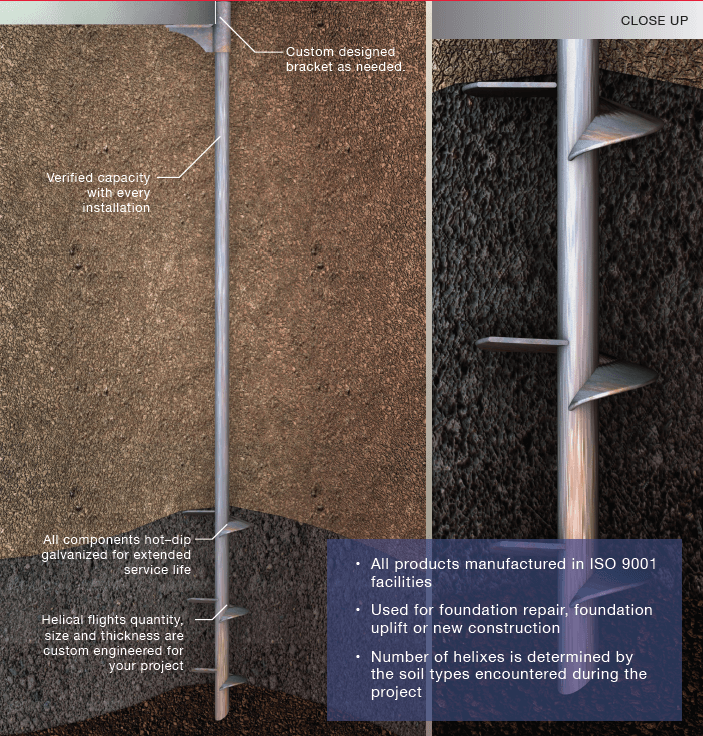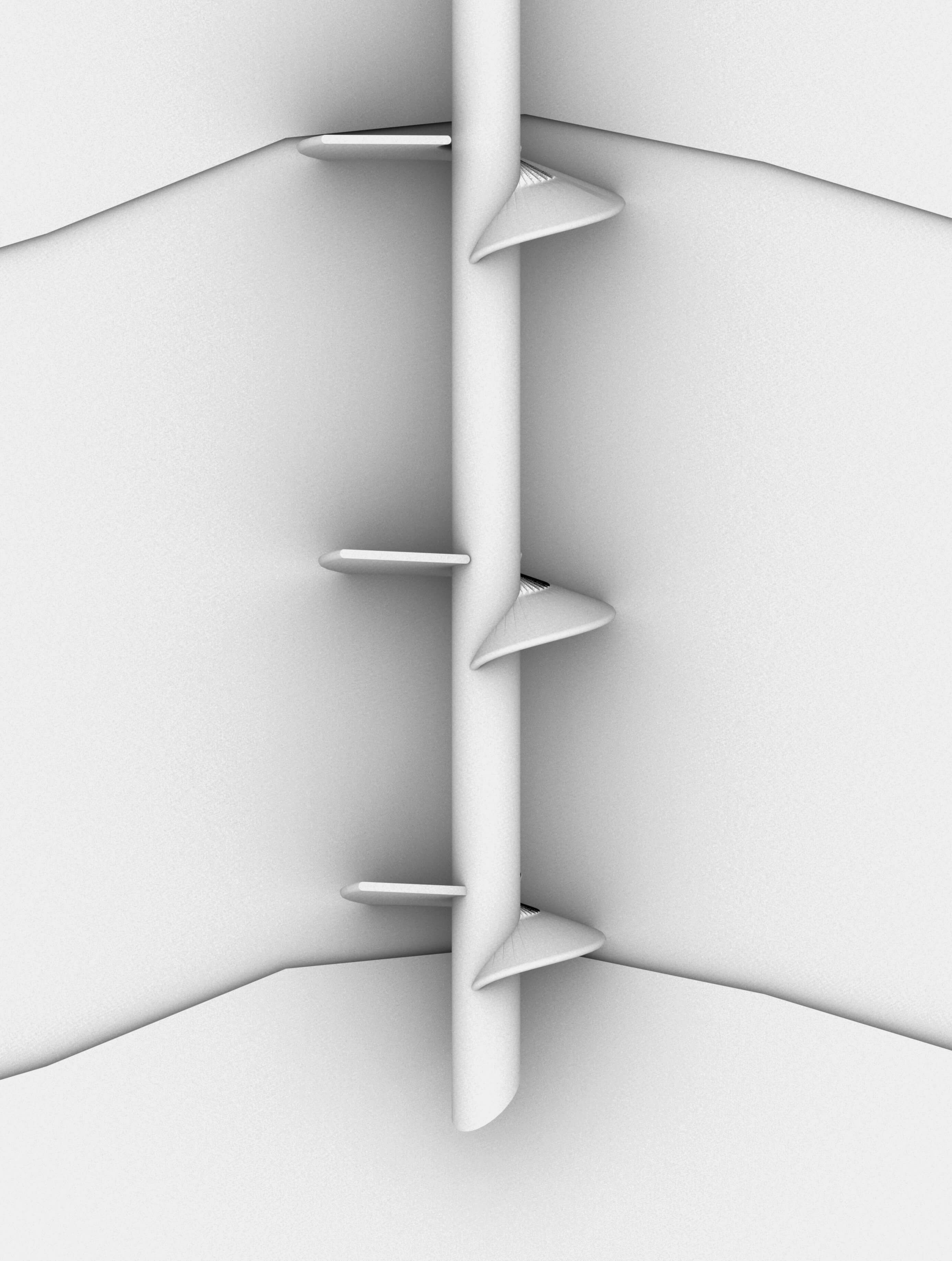Helical Pier Foundation Repair in Dallas, Texas. A Proven Structural Repair Method for both Businesses & Homeowners.
Volatile soil conditions make the Dallas Metroplex a prime area for foundation disruption and damage. As the clay-rich soils of North Texas expand and contract, in close coordination with the rainfall cycle, concrete foundations will begin to heave and sag, leaving them susceptible to cracks and other foundation problems.
This constant cycle of contraction and expansion can compromise the structural integrity of the foundation, putting an enormous stain on the commercial building or home it was intended to support.
When early-stage foundation damage is left unaddressed, it can set off a catastrophic chain reaction that could leave your business (or home) in desperate need of repairs. If you run a commercial enterprise or lease commercial property, significant foundation damage could force you to close your doors for weeks, disrupting your business.
The best way to avoid stoppages in business operations is to address emerging foundation problems at the first sign of trouble.
There are a variety of methods to repair foundation damage, and helical piers can often be one of the most effective ways to get the job done.
What are Helical Piers?
Helical piers are long, extendible, cylindrical support shafts made from non-corrosive galvanized steel. Welded to the shafts are sharpened, curving steel plates (known as helixes), angled to allow progressive ground penetration through machine-driven rotation.
Helical piers can be “screwed” into the soil, in other words, going deeper and deeper with each successive turn until the desired depth is achieved. Unlike augers that carve out a hole as they turn, helical piers do not displace prodigious quantities of soil, making installation a relatively quick and mess-free process.
Like concrete piles or push piers, helical piers are installed vertically, under commercial buildings (or homes) to lift and stabilize sagging foundations. Helicals are bend and break-resistant, and can support even the heaviest of structures.
While the helical plates are designed to facilitate deep-ground penetration, that is not their only purpose. They offer additional structural support to the shaft assembly by passing load-bearing responsibility into the surrounding soil, where they are firmly anchored on the horizontal plane.
The compression-force generated by the building above is essentially absorbed into the earth, giving helical piers a strength advantage over piers or pilings that lack “wing” attachments that must rely entirely on vertical shafts to provide foundation reinforcement and support.
Helical piers have been tested for generations, delivering proven results based on countless industry case studies. The long-standing performance record of the helical pier foundation repair system has earned high marks from structural engineers throughout Texas.
Helical Pier Installation
When slab foundations begin to sag, they must be lifted to increase their supportive capacities. They must also be reinforced from below to make sure they don’t sink back into the earth again over time.
Some foundation repair methods require access to the inside of the structure, so holes for piers or piles can be drilled through the floor. Theoretically you could do the same with helical piers, but this level of disruption is usually unnecessary. The installation of helical piers can instead take place outside, around the building’s perimeter. The piers go in parallel to the walls, ready to support the weight of the building once the installation process is complete.
Using portable driving machinery, Olshan Certified Structural Technicians will screw in each pier to the desired depth. Pier sections are added as needed to increase the length of the helical pier assembly, which will be screwed into the ground as deeply as necessary to achieve stability.
Once a helical pier has been screwed in far enough to reach bedrock, or earth that has been compacted enough to support the weight of the building above it, the top of the pier is connected to a heavy bracket that lifts and holds the foundation wall. The bracket helps to restore the foundation, while the helical pier locks the entire commercial structure (or house) into place, protecting it from further heaving or sagging.
Advantages of the Helical Pier Method
Helical pier foundation repair might not be the best choice in every situation, but it is often worth considering for qualifying Dallas business or homeowners. The long list of advantages provided by the helical pier system in comparison to other repair technologies make it a great option under the right circumstances.
Those advantages include:
- Minimal site disturbance: Little soil is displaced during the helical pier installation process, mitigating mess to the surrounding landscape.
- Speedy installation: Multiple helical piers can be inserted by a small team at various spots around a building’s perimeter, often in less than a day.
- Flexibility: This ingenious lift and anchor technology is appropriate for a wide range of soil conditions, home or business locations and building weights.
- Powerful soil engagement: The addition of steel plates to anchor the piers in the soil adds compression and tension strength and makes the piers move-resistant.
- Superior depth: By adding sections, it’s possible to insert helical piers dozens of feet below the ground, which can be difficult to achieve with other pier/piling technologies.
- Wetlands stability: Helical piers are made for moisture-saturated soils, since they can be inserted to impressive depths well below the wet zone.
- Easy access for work crews and equipment: Helical pier insertion/torquing equipment is relatively compact, lightweight and convenient for use in challenging locations (i.e., when buildings are constructed on hillsides or in crowded spaces).
- Longevity: Extra-firm anchoring plus corrosion-resistant galvanized steel gives helical piers an increased lifespan.
- Removable: Helical piers make sense for use with temporary structures, since they can be screwed out with the same equipment used to screw them in.
- Vertical or horizontal installation is possible: Helical piers can be installed in firm soil at any angle, which makes them ideal for retaining walls or basement walls bulging from underground horizontal water pressure (an alternative source of foundation damage).
- Extensive range of weight compatibility: Because they’re capable of supporting super-heavy structures, helical piers are a great choice for commercial and industrial buildings.
Costs for helical pier installation generally runs a few thousand dollars, depending on how many piers you need. At Olshan we do have several convenient payment plans available that can help you manage the expense, should you decide to go in this direction.
Helical Piers are Excellent for Both Commercial Building and Residential Application
Fast installation, minimal disruption and superior support strength make helical piers a great choice for just about any type of structure, including commercial buildings of all sizes.
If you are concerned about the stability and condition of your foundation, call Olshan right away and we’ll dispatch a Certified Structural Technician to make an assessment as quickly as we can.
Helical Pier Foundation Repair is Available in the Dallas, TX Metroplex & Surrounding Areas
We provide service in Dallas, Ft. Worth, Carrollton, Plano, Lewisville, Mesquite, Garland, Waxahachie, The Colony, Richardson, Coppell, North Richland Hills, McKinney, Arlington, Irving, Hurst/Euless/Bedford, Grand Prairie, Frisco, Denton, Weatherford, Mansfield, Grapevine and other surrounding locations.
Call 972-238-1600 for more information about services available in your area.


